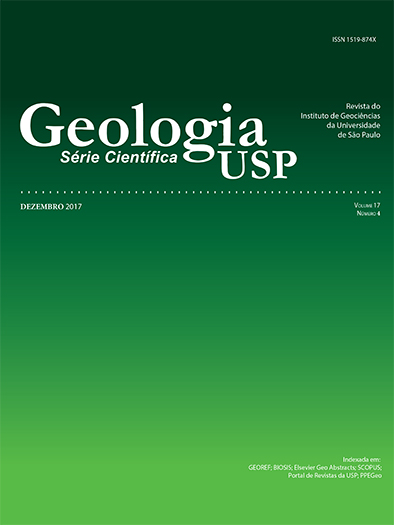Chloritic alteration in the east flank of the Caçapava Granite, State of Rio Grande do Sul: metasomatic evolution and associated Cu-Fe sulfides
DOI:
https://doi.org/10.11606/issn.2316-9095.v17-121013Keywords:
Chloritites, Hydrothermal alteration, Metasomatism.Abstract
This work investigated the origin and evolution of chloritites and chlorite bearing rocks and Cu-Fe sulfides, associated with sill and apophysis of the Caçapava Granite, which intrude in the dolomitic marbles of the Passo Feio formation, Terrane São Gabriel of the Sul-Riograndense Shield. The interaction of the granite fluids with the marbles generates high- and low-temperature mineral associations. The low-temperature alteration halos on the granitoid are mainly constituted of chlorite followed by albite titanite, sulfide and rare rutile. Chlorite, calcite and, eventually, serpentine, talc and sulfides constitute the low-temperature alteration in the country-rock marbles. The alteration halos are distributed in domains along the granitoid matrix as well as in stock-works or in hydrothermals breccias and its related fractures with chalcopyrite and pyrite. Important hydrothermal metassomatic alteration processes have been identified, notably, chloritization and albitization in the granitoid protholite. The alteration is progressive in the granitoid apophyses, with modifications since incipient to the rocks mainly constituted of chlorites, culminating in the generation of chloritites. The nucleation and growth of chlorite develops from the substitution of biotite and of plagioclase, or deposits it in empty spaces of carbonatic country-rocks. The mass balance by the isocon method indicates that the chloritization process developed through the enrichment of MgO and FeO and depletion in SiO2, K2O and Na2O in the protholite granitoids. The abundance pattern and distribution of rare-earth element (REE) belonging to Complex Granitic Caçapava do Sul. Geothermometry of chlorite composition indicates an average temperature between 280 and 300ºC for the chlorite formation.Downloads
Download data is not yet available.
Downloads
Published
2018-02-20
Issue
Section
Articles
License
Authors who publish in this journal shall comply with the following terms:
- Authors keep their copyright and grant to Geologia USP: Série Científica the right of first publication, with the paper under the Creative Commons BY-NC-SA license (summary of the license: https://creativecommons.org/licenses/by-nc-sa/4.0 | full text of the license: https://creativecommons.org/licenses/by-nc-sa/4.0/legalcode) that allows the non-commercial sharing of the paper and granting the proper copyrights of the first publication in this journal.
- Authors are authorized to take additional contracts separately, for non-exclusive distribution of the version of the paper published in this journal (publish in institutional repository or as a book chapter), granting the proper copyrights of first publication in this journal.
- Authors are allowed and encouraged to publish and distribute their paper online (in institutional repositories or their personal page) at any point before or during the editorial process, since this can generate productive changes as well as increase the impact and citation of the published paper (See The effect of Open Access and downloads on citation impact).
How to Cite
Reis, R. S. dos, Remus, M. V. D., Dani, N., & Anzolin, H. de M. (2018). Chloritic alteration in the east flank of the Caçapava Granite, State of Rio Grande do Sul: metasomatic evolution and associated Cu-Fe sulfides. Geologia USP. Série Científica, 17(4), 61-79. https://doi.org/10.11606/issn.2316-9095.v17-121013





